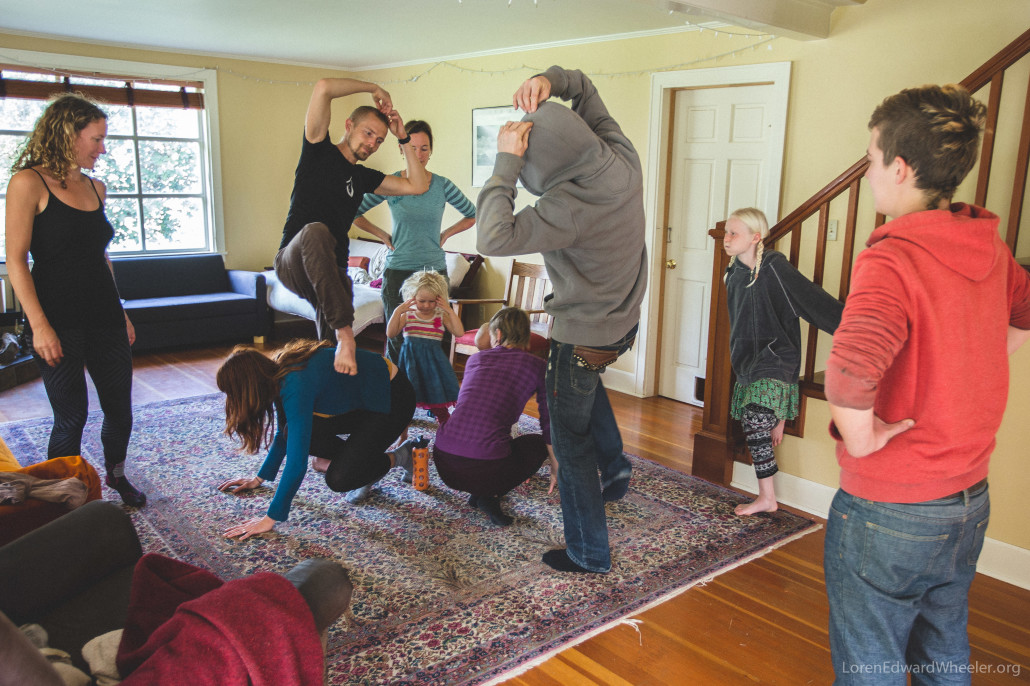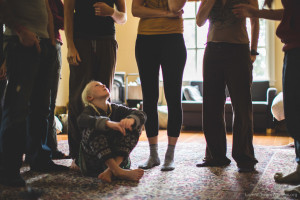Theatre of the Oppressed at Full Bloom
We recently had our second “Theatre of the Oppressed” workshop here at Full Bloom, led by our friend Eliot, a wonderful performance artist and facilitator of this dynamic and unique form of theater. Here’s is synopsis of the form:
As created by Brazilian visionary Augusto Boal, Theatre of the Oppressed (T.O.) is a form of popular community based education which uses theater as a tool for social change. It’s basic aim is to re-humanize humanity. Originally developed out of Boal’s work with peasant and worker populations, it is now used all over the world for social and political activism, conflict resolution, community building, therapy, and government legislation. Designed for non-actors, it uses the universal language of theatre as a springboard for people and whole communities to investigate their lives, identify their dreams, and reinvent their future. Not a soapbox, T.O. invites critical thinking and dialogue. It is about analyzing rather than giving answers. It is also about “acting” (taking action) rather than just talking. With T.O., people can and often do discover empowering solutions to their own struggles. And they have a good time doing it.
He is serious about the “good time” part of the description. The workshops have been extraordinarily fun. In turns out that the serious, charged and complex material of social oppression really needs movement, mirth, and play in order to be fully and sustainably explored. Cause at the end of the day we’re not going to be motivated to explore and heal oppression if its heavy, lacks movement, and is completely devoid of laughter.
In T.O. participants are incredibly supported in the exploration of oppressions they feel in their daily life (such as money, ageism, racism, physical disability, sickness, isolation etc.) by having some of their feelings, thoughts, and stories on the matter reflected back to them by “players” (BTW all of the participants in the workshop are spectactors, meaning they both witness whats happening and are actively engaged in the games and theatrics).

An warm up game where everyone partnered up with someone in the circle and attempted to mirror back their movements to the best of their ability. That’s Eliot in the red hoodie.
What I took home as the higher purpose of T.O. was this: to refelct the tender complexity of the human condition so that we may be genuinely heartened, grow in our understanding of humanity and maybe even laugh at the messes we get ourselves into personally and collectively. I really appreciated the sense of togetherness that it generated which felt much fuller than what often happens in a simple “sharing circle” where everyone shares their personal stories or challenges as if they are theirs alone, when it actuality everyone has versions of feeling excluded, oppresses, or unjustly treated. I’m looking forward to taking this form deeper as we continue to grow as a community through all the inevitable conflict, oppression, and confusion.
 “When we look beyond appearences, we see oppressors and oppressed people, in all societies, ethnic groups, genders, social classes and casts; we see an unfair and cruel world. We have to create another world because we know it is possible. But it is up to us to build this other world with our hands and by acting on the stage and in our own life” Augusto Boal
“When we look beyond appearences, we see oppressors and oppressed people, in all societies, ethnic groups, genders, social classes and casts; we see an unfair and cruel world. We have to create another world because we know it is possible. But it is up to us to build this other world with our hands and by acting on the stage and in our own life” Augusto Boal






















